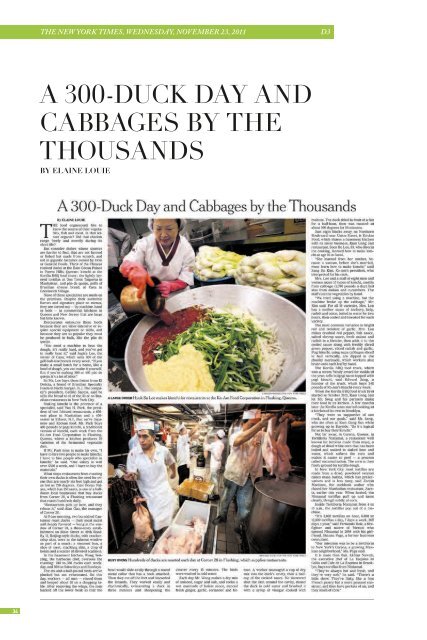The Korean Wave 2010-2011 - Korean Cultural Service
The Korean Wave 2010-2011 - Korean Cultural Service
The Korean Wave 2010-2011 - Korean Cultural Service
Create successful ePaper yourself
Turn your PDF publications into a flip-book with our unique Google optimized e-Paper software.
<strong>The</strong> New York Times, Wednesday, November 23, <strong>2011</strong>D3A 300-Duck Day andCabbages by theThousandsBy ELAINE LOUIE<strong>The</strong> food cognoscenti like to know the source oftheir vegetables, fish and meat. Is that lettuceorganic? Did that chicken range freely andmerrily during its short life?But consider dishes whose sources are harder to find,that are not farmed or fished but made from scratch,and not in gigantic factories owned by Dole or GeneralFoods. Think of the Chinese roasted ducks at the EastOcean Palace in Forest Hills, Queens; kimchi at theKorilla BBQ food truck; the lightly layered tortillas atDos Toros Taqueria in Manhattan; and pão de queijo,puffs of Brazilian cheese bread, at Casa in GreenwichVillage.None of these specialties are made on the premises.Despite their authentic flavors and signature place onmenus, they are turned out — by machine, hand orboth — in commercial kitchens in Queens and NewJersey that are large but little known.Restaurants outsource these foods because they arelabor-intensive or require special equipment or skills,and because they are so popular they must be producedin bulk, like the pão de queijo.“You need a machine to beat the dough; it’s reallyhard, and you’ve got to really beat it,” said Jupira Lee,the owner of Casa, which sells 300 of the golf-ball-sizebreads every week. “If you make a small batch for ahome, like a bowl of dough, you can make it yourself.But if you’re making 300 or 400 pão de queijo, it’s alot of labor.”So Ms. Lee buys them frozen from Ki Delicia, a brandof Brazilian Specialty Foods in North Bergen, N.J.<strong>The</strong> company’s president, Getúlio Santos, said he sellsthe bread to 15 of the 30 or so Brazilian restaurants inNew York City.Making kimchi is the province of a specialist, saidYun H. Park, the president of two Ichiumi restaurants,a 600-seat place in Manhattan and a 400-seaterin Edison, N.J., that serve Japanese and <strong>Korean</strong> food.Mr. Park buys 400 pounds of pogi kimchi, a traditionalversion of kimchi, each week from the Ko-Am FoodCorporation in Flushing, Queens, where a kitchenproduces 10 varieties of the fermented vegetable dish.If Mr. Park tries to make his own, “I have to hire twopeople to make kimchi; I have to hire people who specializein kimchi,” he said. “One salary is well over$500 a week, and I have to buy the materials.”What stops restaurants from roasting their own ducksis often the need for ovens that are nearly six feet highand get as hot as 750 degrees. East Ocean Palace,which has 150 seats, is one of a half-dozen local businessesthat buy ducks from Corner 28, a Flushing restaurantthat roasts hundreds daily.“Restaurants pick up here, and they reheat it,” saidAlan Gao, the manager of Corner 28.At 9 one morning, two burnished Cantonese roastducks — their meat moist and deeply flavored —hung in the window of Corner 28, a three-story establishmenton Main Street at 40th Road. By 11,Beijing-style ducks, with cracker-crisp skin, were atthe takeout window as part of a snack: a steamed bun,a slice of meat, crackling skin, a drop of hoisin and ascatter of slivered scallions.In the basement kitchen, Wang Weiying, the barbecuechef, oversees the roasting: 240 to 280 ducks eachweekday, and 300 on Saturdays and Sundays.<strong>The</strong> six-and-a-half-pound birds arrive plucked but noteviscerated. On this day, workers — all men — rinsedthem and heaped about 20 on a chopping table. Afterremoving the wings, the men hacked off the lower beakso that the head would slide easily through a roundmetal collar that has a hook attached. <strong>The</strong>n they cutoff the feet and discarded the innards. <strong>The</strong>y workedeasily and rhythmically, eviscerating a duck in threeminutes and sharpening the cleaver every 15 minutes.<strong>The</strong> birds were washed in cold water.34 35





